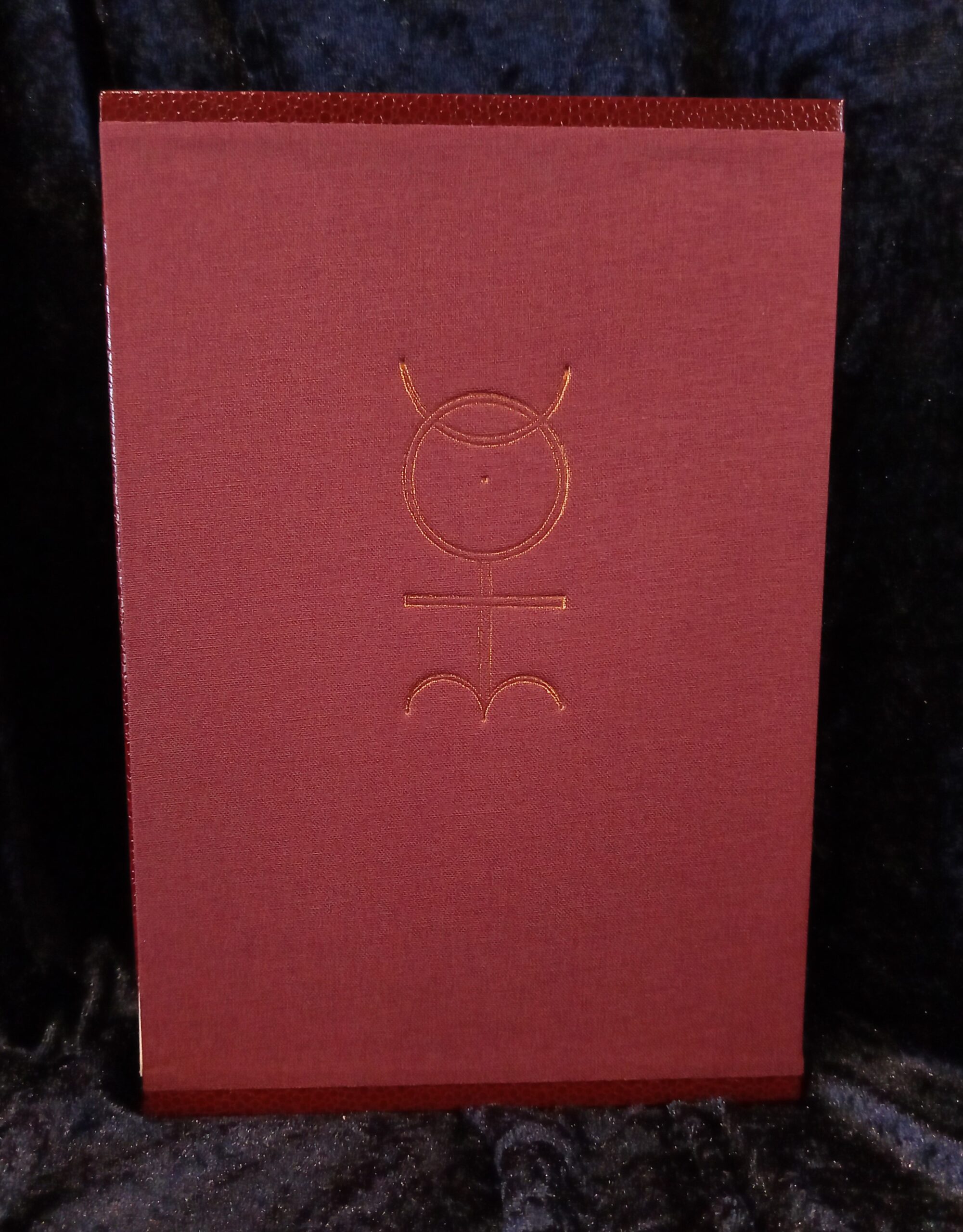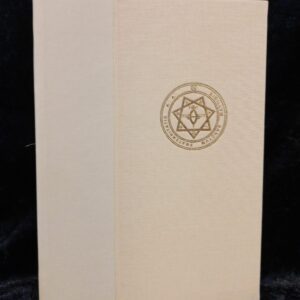£66.00
Two volume box set
Over 200 pages
Limited to 150 hand numbered sets
1 in stock
Description
‘O comfortable allurement, O ravishing persuasion to deal with a science whose subject is so ancient, so pure, so excellent, so surrounding all creatures, so used of the almighty and incomprehensible wisdom of the Creator, in distinct creation of all creatures: in all their distinct parts, properties, natures, and virtues, by order, and most absolute number, brought from nothing to the formality of their being and state.’ John Dee : Euclids Elements 1570
Early Life: The Dee family was Welsh and there exist three pedigrees, two of which are heavily annotated by John Dee and are perhaps based on information supplied to him by his cousin Lewis ap Howell Dee in 1567. There he describes his father as ‘antesignanus dapiferorum’ (‘chief sewer’) to Henry VIII. Rowland Dee was later a merchant and was admitted to the Mercers’ Company of London in 1536. He does not seem to have been a prominent member of the company, and apart from the fact that he was excluded from the pardon issued to those who had taken part in Wyatt’s rebellion in 1554 (but was later none the less pardoned), little is known of him; his son does not record his death. The pedigrees, which trace Dee’s ancestry through the Lord Rhys (Rhys ap Gruffudd) to Rhodri Mawr and Coel Hen, are unlikely to be accurate for more than three or four generations back. His mother owned houses and land in Mortlake which were surrendered to her son in 1579, and it is possible that her family originated there.
Dee was educated at Chelmsford grammar school, and entered St John’s College, Cambridge, in 1542, where he claimed to have studied for up to eighteen hours a day. In 1546 he was elected a fellow and under-reader in Greek at the newly founded Trinity College, and he received his MA in 1548. He is normally styled Doctor Dee, but his only claim to this title seems to be his receiving a doctorate of medicine from the University of Prague in 1584 or 1585. John Chamberlain refers to him as Dr Dee in 1599, and this usage seems to have become accepted after Dee’s death.
The date of Dee’s first marriage, to Katherine, widow of Thomas Constable, a London grocer with whom he had been in some way associated as early as 1558, is unknown but probably took place in 1565 or 1566, after his return from his third continental journey, and his settling at Mortlake. There were no children of this marriage, and Katherine Dee died in 1575; her burial coincided with a visit by the queen to Mortlake. Dee married for a second time, on 5 February 1578; his new wife was Jane Fromond or Fromonds (1555–1605), daughter of Bartholomew Fromonds of Cheam, Surrey. (In Dee’s diary his wife’s name is always Fromonds; elsewhere it appears as Fromond.) There were eight children of this marriage, though only Arthur Dee (1579–1651) and Katherine (b. 1581) seem to have survived their father.
First continental visits, and career to 1558
Dee made his first visit to the continent shortly after his election to Trinity College. His own account of his early travels is contained within the ‘Compendious rehearsal’ which he prepared for the queen’s commissioners in 1592 and revised in 1594. This document, supported by written evidence displayed at the time, was designed to emphasize his services to the state, and, though rhetorical in tone, is accurate in detail. He also made personal entries in printed volumes of ephemerides, though apart from a few entries copied by Elias Ashmole the early volumes have perished. Two volumes, from which J. O. Halliwell published Dee’s notes as his Diary (1842), are Joannes Stadius’s Ephemerides novae ab anno 1554 usque ad annum 1600 (1570) and Joannes Antonius Maginus’s Ephemerides coelestium motuum ad annos XL (1582), both in the Bodleian Library. Dee himself normally followed the practice of these works in reckoning the year as beginning on 1 January. The chronological framework is confirmed by Dee’s notes of ownership in many of his books.
Dee recorded that he visited the Southern Netherlands in May 1547 ‘to speake and conferr with some learned men, and chiefly mathematicians’ (Compendious rehearsal, ed. Hearne, 500–01), whom he names as Gemma Frisius, Gerardus Mercator, Gaspar à Mirica, and Antonio Gogava. He returned to Cambridge after a few months, bearing mathematical instruments designed by Gemma and Mercator which were later presented to the college. His only recorded academic achievement at Trinity was a production of Aristophanes’ Pax in which Trygaeus rode up to the roof of the college hall upon a scarab beetle. This early use of stage machinery caused by his own account ‘great wondring’ and, combined with his interest in the animation of statues and in mechanical toys, contributed to his enduring (though to him highly unwelcome) reputation as a conjuror.
Dee’s return to the Southern Netherlands in the following year may be connected both with his own dissatisfaction with the state of mathematical learning in England and with proposed curricular changes, favouring mathematics, at Cambridge. He may have been sent by a patron: Sir William Pickering proved to be such in 1549. Dee entered the University of Louvain on 24 June 1548, continuing the studies that he had begun in the previous year, which included mathematics, geography, astrology, astronomical observation, and ‘for recreation’ civil law. His presence in both Louvain and Antwerp is attested by inscriptions in his growing library. He left Louvain on 15 July 1550, without receiving any further degree, and five days later arrived in Paris. Rheims College was the scene of his lecturing upon Euclid’s Elements, ‘Mathematicé, Physicé, & Pythagoricé’, to a vast and eager audience. He also relates that he refused the offer of a professorship of mathematics in the University of Paris at a salary of 200 crowns.
Dee returned to England at the end of 1551 and was so well commended to Edward VI by Sir William Cecil and Sir John Cheke that the king granted him an annual pension of 100 crowns, which was commuted into the rectory of Upton upon Severn, Worcestershire, in May 1553, an income which was later augmented with the rectory of Long Leadenham, Lincolnshire. In 1552 he entered into the service of the earl of Pembroke, and later into that of the duke of Northumberland, to whose son, John, earl of Warwick, he seems to have acted as tutor, and of whose aptitude he later spoke with unusual warmth.
With the accession of Queen Mary in 1553 the Dudleys fell from power; Northumberland was executed in 1553, and Warwick died in 1554. Dee then resorted to the teaching of mathematics in London, but declined an invitation in 1554 from Richard Bruern and Richard Smith to read the mathematical sciences at Oxford; notes in his books show that he was in Oxford in April of that year, and may have acquired his first recorded pupil, Christopher Carye, there. He was in London in the following year, and was admitted by patrimony to the Mercers’ Company, thus gaining access to merchants, such as Sir Lionel Duckett and the Loks, who were to make use of his mathematical and navigational skills in trading ventures such as the Russia Company, and in the quest for the north-east and north-west passages.





